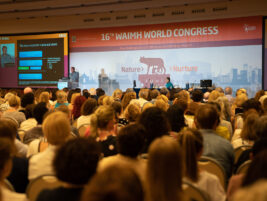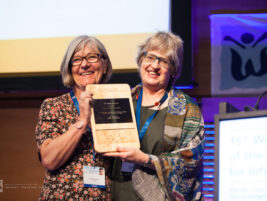Obituary
The editors of the Journal have invited me to highlight in this obituary the contributions of Dan Stern to psychoanalysis. As a longtime friend and colleague who worked with him in many settings, sharing interests in early development, clinical work and the wonders of art and life, I am pleased to do so. Dan wrote books that were widely read and translated into multiple languages. His easy-flowing writing, like his speaking style, almost poetic at times in his use of metaphor and intuition, as well as his gentle way of engaging his audience to join him in exploring a widening world, was wonderful. He was an integrator who took new findings and visions from science and added his own insights gleaned from observations, experiments, and clinical encounters as well as his creative imagination. As Robert Michels put it, in his moving memorial given at Rockefeller University in New York on 6 December:
Dan built bridges, and was extraordinarily skillful at moving back and forth across them and leading others to follow him. Bridges between research and practice, between developmental psychology and dynamic psychotherapy, between infant observation and clinical reconstruction, between the interpersonal and the intrapsychic, between science and art, between explanation and understanding.
A bit of biography. Born and raised in New York, he attended Harvard University, Albert Einstein College of Medicine, received some training in internal medicine at Belleview Hospital, following which he spent two years at the National Heart Institute doing research, then completed his psychiatry residency and his psychoanalytic training at Columbia University. His academic career included faculty positions at the medical schools of Columbia, Cornell and Brown as well as at the faculty of psychology and sciences of education at the University of Geneva. During the last 25 years of his life, his primary residence was in Geneva but he commuted to New York where he also maintained a residence and adjunct appointment in psychiatry at Cornell. His international prominence was indicated by a myriad of invited lectureships in Europe and the United States, various prizes as well as five honorary degrees (Universities of Palermo and Padua in Italy, of Copenhagen and Ailborg in Denmark, and the University of Mons-Hainault in Belgium). I will add some more personal aspects of his biography as I reflect on some of his enduring psychoanalytic contributions. Stern moved us to thinking about the dynamic aspects of experience, over time, both in the course of early development and within the therapeutic encounter. In his writings, a reader can typically link his working concepts to advancing scientific knowledge about the processes of experiencing. And this is so as we think about experiencing from the outside – where it can be thought of as interpersonal as well as personal – and from the inside where it can be thought of as intersubjective as well as subjective. Many of his concepts are intuitively appealing to clinicians and developmental scientists and have been influential already in psychoanalytic literature and training. I reflect here on three areas of experiencing that continue to suggest new questions for theory and practice.
Experiencing the other in early development
Stern’s writings about experiencing self-with-other and modes of intersubjectivity have helped to generate a transformational shift in psychoanalytic thinking, particularly with regards to early development. Before Stern’s writings, the word ‘intersubjectivity’ was virtually absent within our psychoanalytic discourse; now it is commonplace. Now, even though psychoanalysis is being acknowledged more and more as a two-person rather than a one-person psychology, it is still difficult to think of a developing subjectivity shared between us as well as a self-with-other within us and Stern’s writings have much to contribute. Not only did Stern usefully bring forward Colwyn Trevarthen’s ideas of an intersubjectivity present in earliest infancy, but he also wrote about it compellingly from the mother’s point of view as well as the infant’s. The infant is born to be social and sharing at the beginning and, even though dynamic development follows, earlier psychoanalytic ideas of egocentrism followed by later socialization and ideas of fixed stage theories were shown to be inconsistent with emerging developmental observations and knowledge. In The Interpersonal World of the Infant: A View from Psychoanalysis and Developmental Psychology, Stern (1985) vividly portrayed the overlapping phases of the early development of self-withother relating it to observations, experiments and his ideas of cognitive representations of interactions with significant others. In that book he bridges cognitive science with psychodynamic and attachment theory and, as importantly, with affective science. His formulation of ‘vitality affects’ and of ‘affect attunement’ and its significance in early parent–child interactions, later elaborated in Forms of Vitality: Exploring Dynamic Experience in Psychology, Art, Psychotherapy and Development (Stern, 2010), have been influential in early prevention programs as well as in elaborating psychoanalytic notions of ‘emotional availability’ as originally put forth by Margaret Mahler and later by our group. In The Journal of a Baby, Stern (1990) puts his ideas in a purely literary mode. He imagines, poetically and empathically, what the baby feels, experiences and would tell us in a diary about what is important in an ongong intersubjective world.
In The First Relationship: Infant and Mother (Stern, 1977), and later in The Motherhood Constellation: A Unifying View of Parent–Infant Psychotherapies (Stern, 1995) and in The Birth of a Mother (written with Nadia Bruschweiler-Stern, 1997), the experiencing of the mother is given emphasis, specifying and expanding Donald Winnicott’s insights of ‘primary maternal preoccupation’ and updating it with additional interdisciplinary knowledge and thinking. Although Stern brings a main focus in these cited works to newer insights about normal development and adaptation, there is discussion of ‘misattunements’, or what Ren!e Spitz referred to as ‘derailments of dialogues’ – with special attention to interventions with depressed mothers. His continuing interests in early preventive interventions for disruptions and what became known as infant psychiatry are contained in many of his published articles and chapters. When we formed a group to work on early developmental psychopathology at the Center for Advanced Study in the Behavioral Sciences at Stanford, Dan commuted intermittently from New York to join our group and contributed to the specification of ‘relationship disturbances and relationship disorders’, with a chapter in our edited book (Sameroff and Emde, 1989). His contributions to thinking about the significance of intersubjectivity in clinical work lead to my next reflections.
Experiencing what matters in therapy
Perhaps Stern’s most influential contributions to psychoanalytic thinking – and those giving us a basis for research and practice yet-to-come – are presented to us in his writings on psychodynamic psychotherapy. In The Present Moment in Psychotherapy and Everyday Life, Stern (2004) points out that psychoanalytic therapy for nearly a century tended to neglect the interpersonal everyday world of the patient, and this motivates his directing our attention to the centrality of interpersonal exchanges and intersubjective moments in therapeutic action. As the book’s title suggests, he focuses on small units of time that he refers to as ‘present moments’. These have remarkable characteristics. They typically occur in an average of 3–4 seconds, with a range of 1–10 seconds, and are the length of phrases of speech, turns in dialogue, and music corresponding to what can be done in a breath cycle. He conceptualizes these as basic units of subjective experience in which ‘schemas of being with’ occur. He elaborates that present moments are complex aspects of experience that involve simultaneous parallel processing with implicit, intuitive and procedural non-conscious activity, often modeled according to ‘time intensity affects’ and with ‘temporal feeling shapes’ that organize them. Further, there is an intimate context for lived experience, referred to as an ‘intersubjective matrix’, that resides in the connectedness with others and that we breathe continuously without being aware of it, like oxygen. Thus, in psychotherapy, individual consciousness is extended to include ‘intersubjective consciousness’, and much of what happens occurs between two people who are closely connected and guided by ‘implicit knowing’. Repeated intersubjective exchanges of two people give rise to an emergent experience, ‘moments of intersubjective meeting’. In addition to joining, such moments result in frequent mismatches that present opportunities for negotiation and correction. They occur throughout a psychotherapeutic relationship, and are largely implicit not requiring verbalization in order to have their therapeutic effects. Verbal interpretations of the intersubjective field are complementary acts. Thus psychotherapy consists of a series of present moments, driven forward by a desire for intersubjective contact, and with important ‘moments of meeting’ between patient and therapist. For Stern, change takes place through a rewriting of past experiences as lived, and as the temporal dynamics of the past are activated bringing an influence on present behavior. What is experienced is in the present, happening in real time so that a story can be re-written.
The paper entitled Non-interpretive mechanisms in psychoanalytic therapy: The something more than interpretation (Stern et al., 1998), published in this Journal, deserves special mention, as it has been listed in the Archival PEPWeb as the most cited of all its publications among users. This paper and others from what is referred to as ‘the Boston Psychotherapy Group’ will continue to provide contributions, in my view, to psychoanalytic thinking about training, practice and research. It begins with the well-known observation that patients, when asked about what made for a successful analytic treatment, tend to remember special moments of person-to-person connection as much as interpretations that made a difference. In this paper, exploring the ‘something more than interpretation’, the authors expand upon the concept of the ‘shared implicit relationship’ in psychoanalytic therapy and connect it with experiences of transference and countertransference. They elaborate how ‘implicit relational knowing’ is distinct from the symbolic domain and connect it meaningfully to its early manifestations in infant development as well as its manifestations in therapy within a shared intersubjective relational domain. Moments of meeting are described in general dynamic systems terms originally formulated by the developmental psychoanalyst Louis Sander (a member of the group who also died in November 2012); they are key to state shifts and regulatory reorganization and, in supplementing interpretations, they provide much of what is lasting in therapeutic effects. It would seem the paper is ‘most cited’ because it compellingly describes the sequences leading up to such moments of meeting and afterwards using terms that link to many of the clinical concepts of psychoanalysis that are in use today. It also introduces a landscape for what needs be pursued with clinical research and practice.
Experiencing ways of connecting
In reflecting on Stern’s contributions to psychoanalysis, one also thinks of his style of communicating with us. Not only in his writings but also in his presentations and collaborations, he made use of a style of connectedness from which I believe we can learn. When presenting, rather than reading from notes or using PowerPoint, he would speak directly, moving from the immediacy of one posed question to another. He would develop a story, with his audience, with lots of eye-to-eye contact and playful expressions as he shared ongoing thinking with engaged listeners. If he used any prop it would typically be an extension of a gesture, drawing a directional chalk line on a blackboard. You might say he had a special sensitivity for engaging intersubjectivity in an audience of others.
The details of connecting with his interesting life and legacy can be left to future biographers, but two themes occur to me, related to these reflections. The first includes the fact of his having experienced a series of heart attacks beginning in his late 30s. Surviving these led to a sense of gratitude and to a conscientious healthy life style. And it also gave him a continuing sense that he was ‘living on borrowed time’, valuing each moment as precious for himself and with others. The second is one I only learned of at his memorial, from his surviving older sister, Ronnie Chalif, who described to those gathered how, in early childhood, he compellingly appealed to their depressed and nonverbal mother who was in that condition for an extended period following the death of their father. His sensitivity to connecting via nonverbal behavior was seemingly early and lifelong.
Dan had a love of art, especially dance, which entered into many of his metaphors, and in adulthood he had a close friendship with Jerome Robbins to whom one of his books was dedicated. In the dance of his life with others, and in the midst of adversity, he was typically positive about possibilities. Especially for those of us who knew him, we continue to share in our memories his creative playfulness in the midst of urging us in psychoanalysis to be more critical in our thinking, participate more in science and be open with others.
He is survived by his wife, Dr. Nadia Bruschweiler-Stern; two sons, Michael and Adrien; three daughters, Maria, Kaia and Alice Stern; a sister, Ronnie Chalif; and 12 grandchildren. At his memorial his grandchildren tenderly lit candles as memories were addressed to them. The back of the printed program, in enlivening colors, quoted Dan: ‘Just have fun’.
References
Sameroff, A.J., Emde, R.N., editors (1989). Relationship disturbances in early childhood: A developmental approach. New York, NY: Basic Books.
Stern, D.N. (1977). The first relationship: Infant and mother. Cambridge, MA: Harvard UP.
Stern, D.N. (1985). The interpersonal world of the infant: A view from psychoanalysis and developmental psychology. New York, NY: Basic Books.
Stern, D.N. (1990). The diary of a baby. New York, NY: Basic Books.
Stern, D.N. (1995). The motherhood constellation: A unifying view of parent–infant psychotherapies. New York, NY: Basic Books.
Stern, D.N. (2004). The present moment in psychotherapy and everyday life. New York, NY: Norton.
Stern, D.N. (2010). Forms of vitality: exploring dynamic experience in psychology, art, psychotherapy and development. Oxford: Oxford University Press.
Stern, D.N. & Bruschweiler-Stern, N. (1997). The birth of a mother. New York, NY: Basic Books.
Stern, D.N., Sander, L.W., Nahum, J.P., Harrison, A.-M., Lyons-Ruth, K., Morgan, A.C., Bruschweiler-Stern, N. & Tronick, E.Z. (1998). Non-interpretive mechanisms in psychoanalytic therapy: The something more than interpretation. Int J Psychoanal, 79:903–21.
Authors
Emde, Robert N.,
Colorado, United States,
E-mail: Bob.Emde@ucdenver.edu







